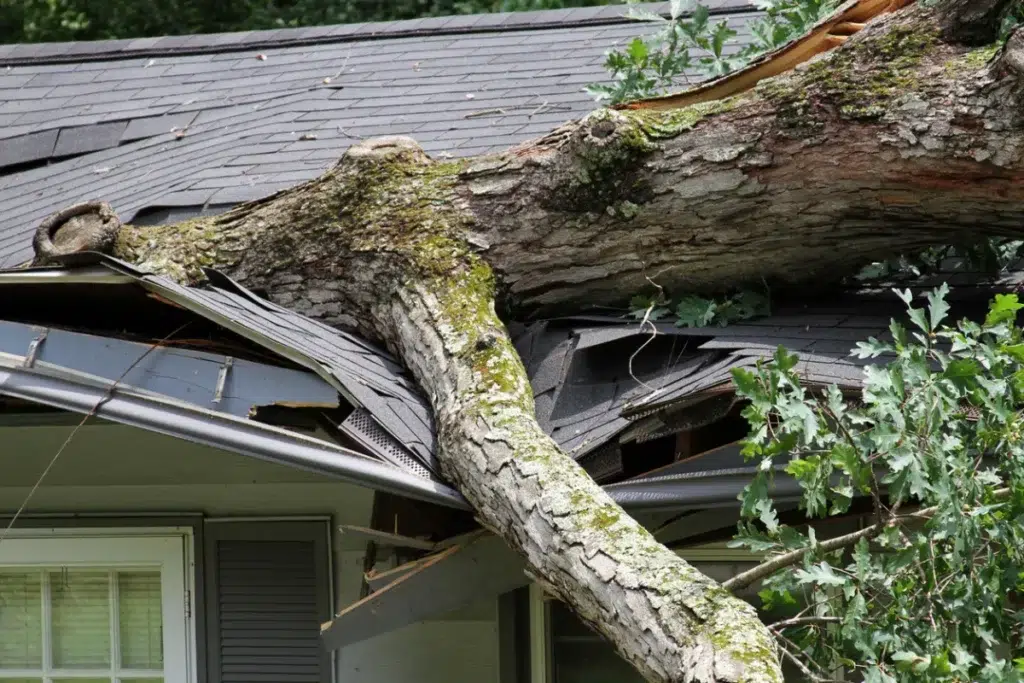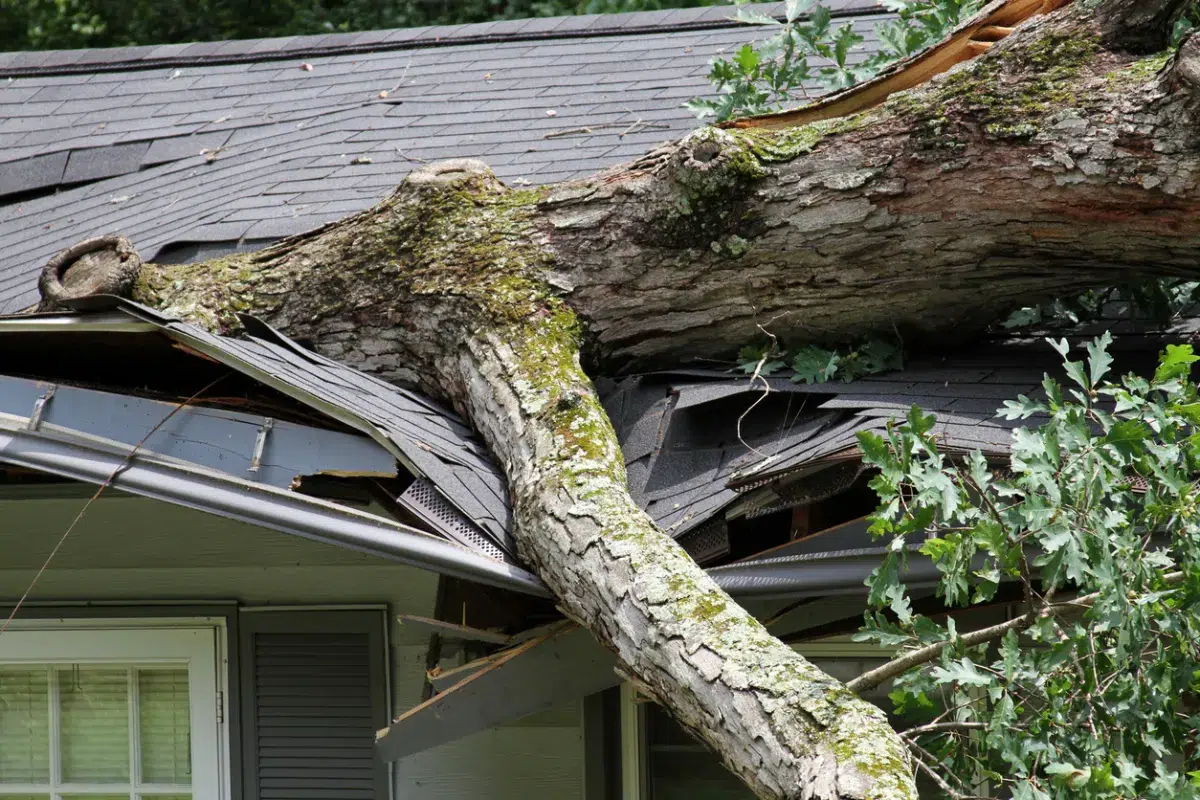
Storm-torn shingles, loose flashing, and sudden leaks often send homeowners scrambling to file an insurance claim. But all too often, those claims stall, or worse, come back stamped “denied.” We know how frustrating that can be because we’ve seen it time and again.
The good news? With the right preparation, solid documentation, and the willingness to push back, you can improve your chances of a fair payout. In this article, we’ll walk you through the claims process, highlight common traps that lead to rejections, and explain what steps you can take when an adjuster says “no.”
And if you hit a wall, our team at Kennon Law, led by Board Certified Civil Trial Attorney Hans Kennon, is here to fight for you and hold insurance companies accountable.
How the Roof Damage Claim Process Works
Each carrier has its own forms, yet most claims follow the same track. You notify the company, an adjuster inspects, and the carrier decides whether to pay for repair or replacement. Missing a deadline or key document can sink the insurance claim long before anyone climbs a ladder.
Before storms ever roll in, read your insurance policy’s storm sections. Look for wind or hail deductibles, cosmetic-only exclusions, and any separate rules for older roofs. Those fine lines shape every decision the adjuster makes later.
Roofing contractors play a key part. A trusted crew can photograph damage, write a line-by-line estimate, and spot hidden problems an adjuster might overlook. Make sure to gather evidence by saving every photo, video clip, dated weather alert, and text message regarding necessary repairs; clear, time-stamped proof forms the backbone of a strong submission.
- Report the claim fast, often within 24 to 72 hours of the storm.
- Attach photos showing missing shingles, punctures, and interior leaks.
- Request a written estimate from a licensed roofer before the adjuster visits.
- Keep digital and paper copies of all emails and letters.
Common Reasons Why Roof Damage Claims Are Denied
Insurers lean on several standard arguments to turn down roof requests. Knowing them upfront helps you prepare counter-evidence against claims of pre-existing damage.
1. Pre-Existing Damage
Insurance companies often deny roof claims by asserting that the damage existed long before the reported incident. They may argue that signs of aging or previous issues, like faded shingles or old water stains, indicate wear and tear rather than storm-related damage. To counter this, policyholders should be ready with documentation that proves the roof’s prior condition and maintenance history, distinguishing between old and new damage.
2. Workmanship Issues
Even when a storm causes damage, insurers can reject a claim if they determine the roof was installed incorrectly. Common examples include improper nailing, poorly sealed flashing, or structural shortcuts. Because most policies exclude coverage for construction defects, carriers may attribute the damage to shoddy workmanship rather than a covered event.
3. Excluded Types of Damage
Policy exclusions often create hurdles even when damage appears obvious. Claims may be denied for wind-driven rain that enters without harming the structure, cosmetic hail damage that doesn’t affect performance, or surface dents that leave the deck intact. These exclusions are usually buried in policy language and can be used to justify withholding payment.
4. Costs Below the Deductible
If the insurer’s estimated cost of repairs doesn’t exceed your deductible, they won’t issue a payout. This can happen when adjusters minimize the scope of damage or apply conservative pricing. Policyholders often need to bring in independent assessments to challenge low estimates and prove that repair costs are legitimately higher.
5. Lack of Maintenance
Roof damage claims can also be denied when there’s evidence of poor upkeep. Insurers may point to signs of neglect, like moss growth, clogged gutters, or long-ignored wear. These conditions, often arising from incorrect installation, allow them to argue that the damage was preventable and that the homeowner failed to meet their responsibility to maintain the property.
How Insurance Adjusters Assess Storm Damage
The adjuster’s visit is one of the most influential moments in the insurance claims process. What they document, or overlook, often becomes the foundation of your claim’s value and outcome. During the inspection, adjusters will thoroughly examine each slope of your roof, lift shingles to assess the integrity of the seal strips, and use chalk to highlight potential hail strikes or visible bruising, all subject to insurance adjuster interpretation. These markings, combined with photos and notes, form the initial damage report that drives the insurer’s decision and repair estimate.
However, the type of adjuster inspecting your roof can significantly influence the findings. Staff adjusters who are employed directly by the insurance company may be inclined to limit the scope of recognized damage to reduce the carrier’s liability.
On the other hand, independent adjusters hired by the insurer, or public adjusters hired by you, may take a more comprehensive approach, often identifying secondary or subtle damage that company adjusters might miss. These can include ventilation issues, flashing defects, underlayment tears, or code violations—factors that can materially increase the claim’s value.
To strengthen your position, it’s a smart move to have your roofing contractor present during the adjuster’s visit. Their presence ensures another qualified professional is on site to provide immediate context, highlight areas of concern, and advocate for a more thorough evaluation. This reduces the risk of oversight, especially when the damage isn’t immediately visible to an untrained eye or when code compliance comes into play.
If the initial inspection leads to a claim denial or lowball estimate, don’t assume the matter is closed. You have options. You can formally request a re-inspection in writing, giving your roofer another chance to walk the property with a second adjuster.
In many states, you are also entitled to hire a licensed public adjuster to conduct an independent inspection and prepare a competing report. Once both assessments are complete, include a second opinion, present them side by side, and ask the insurance company for a fair review. This comparative approach often helps resolve discrepancies and puts pressure on the insurer to reconsider the scope or valuation of the claim.
Ultimately, a well-documented inspection and a knowledgeable advocate by your side can be the difference between a denied claim and a fully funded roof replacement.
How to File a Strong Roof Damage Claim
A methodical claim package speeds approval and trims back-and-forth emails. Use the steps below as a checklist.
- Notify the carrier using the online portal or phone hotline and jot down the claim number.
- Secure the roof with tarps to stop further leaks, then keep receipts for materials.
- Gather proof: photos, drone shots, weather radar images, and contractor notes.
- Submit the roofer’s estimate that lists part numbers, labor hours, and local code upgrades.
- Track every call and email in a single folder, adding dates and names.
- Follow up weekly until you receive the written decision.
The insurer may promise a decision within 30 days, yet complex claims can stretch longer. Ask for status updates in writing so you have a clear timeline if you need to appeal.
Options If Your Storm Claim Is Denied
A denial letter must state the policy section supporting the rejection. Read that reference and compare it to your proof. Many times, a missing document or unclear photo has led to a refusal.
Start by sending a polite appeal with added evidence: a new contractor report, extra photos, or a second weather log showing hail size. If the carrier digs in, citing issues such as defective products, a licensed public adjuster can recalculate the loss and negotiate on your behalf for a fee capped by state law.
When talks stall, consult an insurance attorney who works on contingency. They review the homeowners’ insurance policy file for “bad faith” tactics such as ignoring clear damage or delaying without cause. You may also file a complaint with the state insurance department, which can pressure the carrier to reopen the file.
| Denial Reasons and Possible Responses | |
| Carrier’s Stated Reason | Action You Can Take |
| Pre-existing wear | Provide contractor proof that the roof was sound before the storm, plus dated photos. |
| Damage below deductible | Request an itemized cost sheet, have the roofer verify full scope, and submit a revised estimate. |
| Faulty installation | Show invoices proving prior proper installation or provide a professional affidavit. |
| Excluded peril (wind-driven rain) | Cite policy language covering openings created by wind, including photos of lifted shingles. |
Tips to Avoid Future Denials on Roof Damage Claims
Preventive steps today guard tomorrow’s claim.
- Schedule a roof check each spring and after major storms, and keep written reports.
- Clean gutters, trim overhanging limbs, and replace cracked shingles to show ongoing care.
- Talk with your agent about wind or hail endorsements that raise limits or lower deductibles.
- Save contractor contact details so you can book a quick post-storm inspection.
Working With Your Insurance Company Effectively
Clear, calm communication often wins faster results than threats. Write, do not just call, and summarize each conversation in an email. When you do not grasp a clause, ask the adjuster to quote and explain it in writing.
Stay firm yet respectful. Point to evidence, not emotions. Thank the adjuster for timely replies, yet keep reminding them of pending items. When both sides share data and carefully review the facts, claims move along and disputes shrink.
If you find the process draining, remember that help exists. Public adjusters, roofing professionals, and seasoned lawyers handle these files every day, working to influence the insurance company. The sooner you bring in support, the sooner you can patch the roof and move on.
Storms may be unpredictable, but your claim game plan does not have to be. By keeping records, leaning on trusted pros, and standing up for a fair reading of your policy, including seeking additional coverage, you place yourself in the best spot for a full and prompt payout.
How We Can Help
Need guidance on a roof claim or a recent denial? Call 888-878-4267, email or visit our contact page.
We answer questions every day and can step in when an insurer drags its feet. Let’s make sure your home gets the sturdy roof it deserves.


